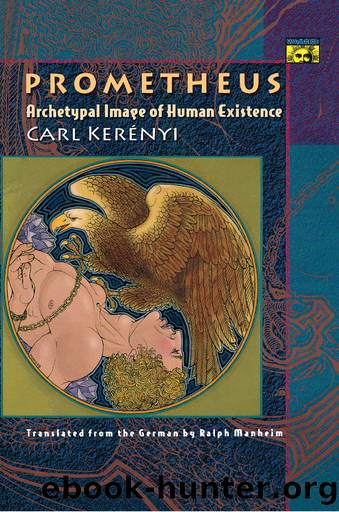Prometheus by Carl Kerényi

Author:Carl Kerényi
Language: eng
Format: epub
Publisher: Princeton University Press
Published: 2020-10-15T00:00:00+00:00
What Is Communicable
TODAY it has become possible to achieve a richer and more concrete view of the Greek world than was conceivable in earlier generations. The mythological dimension of this view can wholly escape no one who does not persist in breaking down the total picture into specialized groupsâone of these being âthe religious.â The new view of the Greek world has not yet been achieved by all those who are occupied with the various branches of specialization, nor is it the final and definitive view. Welckerâs experience was similar to ours, for by considering literature, art, and mythology in one he arrived at a richer and more concrete picture than his predecessors. We have gone far beyond Welcker, but it is interesting to note that he clearly recognized and stated the most important element in the new situation of the science of antiquity. Here it seems worth our while to quote a passage from Welckerâs âSupplementâ on the trilogy of Aischylos, in which he speaks of the role of the mythological tradition in deepening our understanding both of ancient man and of humanism in general. I have italicized those of his remarks that may be particularly relevant today.
âFor anyone today,â wrote Welcker, âwho wishes to pass judgment on the early period of the ancient peoples and on the later works that refer to it, it is just as indispensable to develop a proper understanding and feeling for those early realities as it was in Winckelmannâs time to discover beauty in art if one wished in that day, when something new was being said about marbles and documentsâthese historical sources that had long been availableâto know what was actually being discussed. There were many who simply had no wish to learn; they ridiculed or even vilified the new idea that something they had never seen might be found in the ancient works. An old gentleman in Rome, who was then a young sculptor, has told me what a rage he and his young friends flew into over the young German (quel giovine tedesco) who had suddenly begun to cause a great stir in Rome. Their motto at the time was: l'antico non vale un fico (antiquity isnât worth a fig). But from the way the old man smiled at his former opinions one could only conclude that progress had been made since then. Between Berninesque art and a view of myths which excludes all ideal elements and considers only the material factor in accordance with the most prosaic rational concepts, often exaggerated to the point of caricature, so that the true nature even of an uncultured period ceases to be recognizable, the difference is perhaps not as great as might appear at first sight. But assuredly the comparison is apt to the extent that one must approach both the works of the later art and the myths of the earlier period with intelligence, sensibility, and understanding. These qualities are engendered and molded by the objects themselves; but once the spark is struck, it is communicable.
Download
This site does not store any files on its server. We only index and link to content provided by other sites. Please contact the content providers to delete copyright contents if any and email us, we'll remove relevant links or contents immediately.
Anxious People by Fredrik Backman(2510)
The Last Thing He Told Me by Laura Dave(2165)
The Soulmate Equation by Christina Lauren(1888)
Not a Happy Family by Shari Lapena(1555)
Romancing Mr. Bridgerton (Bridgerton 04) by Julia Quinn(1500)
Slough House by Mick Herron(1388)
Life's Too Short by Abby Jimenez(1371)
The Switch by Beth O'Leary(1364)
Kiss My Cupcake by Helena Hunting(1323)
Solutions and Other Problems by Allie Brosh(1295)
Mordew by Alex Pheby(1247)
This Time Next Year by Sophie Cousens(1174)
A Rogue of One's Own by Evie Dunmore(1094)
No One Is Talking About This by Patricia Lockwood(1057)
The Mary Shelley Club by Goldy Moldavsky(1036)
Playing Nice by JP Delaney(1019)
Roadside Picnic by Arkadi & Boris Strugatsky(991)
Squeeze Me: A Novel by Carl Hiaasen(988)
Quinoterapia by Quino(976)
